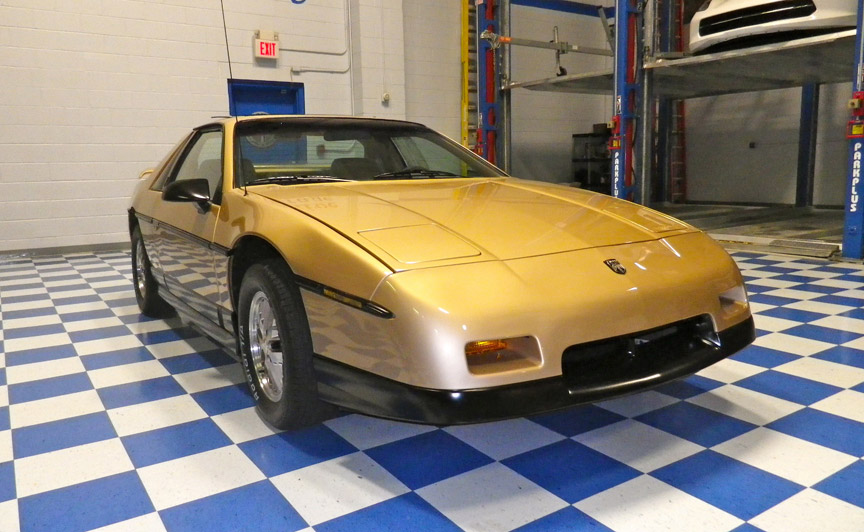Media | Articles
Preservation: A “New” 1986 Pontiac Fiero
A Pontiac Fiero that almost became a Ferrari lookalike kit car now serves as a reference for the model, with just 75 miles from new.
It generated more excitement and demand than its manufacturer initially anticipated. But performance disappointed, and efforts to meet demand resulted in lackluster quality, including occasional engine fires – which all led to sinking demand that doomed the car after five brief years. It was the 1984-1988 Pontiac Fiero.
You don’t see many on the road anymore, and many younger people have never seen one at all except through occasional television and film appearances. The popular show “How I Met Your Mother” built an entire episode around the Fiero. (“Arrivederci, Fiero” season 2, episode 17.)
For anyone curious about the fuss, Hank Venhorst of Rochelle Park, N.J., may have the ideal exhibit – a “new” 1986 Fiero SE V6 with just 75 miles! A Fiero fan since the car’s introduction, Venhorst found this piece of history when he responded to a classified ad for a parts car about 21 years ago.
“It was a ‘Want Ad Press’ listing – that’s how long ago this was,” says Venhorst.
Marketplace
Buy and sell classics with confidence
He took the long drive down to southern New Jersey, where the seller surprised him by saying he was selling everything on the car except the body panels.
“I asked him why he wanted the body panels, and he told me about his other Fiero,” Venhorst says.
The seller showed him a second Fiero stripped to its chassis. To those unfamiliar, Pontiac’s two-seater, introduced for 1984, used a novel construction method. The separate chassis enveloped the passenger cabin in a steel cage and protected the fuel tank in a strong central structure. One outcome was the Fiero earned a five-star crash rating from the National Highway Traffic Safety Administration (NHTSA). The only other car to do so that year was a Volvo wagon.
The Fiero’s plastic (not fiberglass) body panels bolted to the structure and could be removed relatively easily. That made the Fiero an ideal donor car for restyling kits, and before long, there were several on the market. Venhorst had built one that resembled the Corvette. Other models aped the Ferrari 308, the model seen on the “Magnum P.I.” TV show. Pontiac briefly offered a Ferrari lookalike called the Mera through some of its dealers.
Venhorst was intrigued by the story behind the stripped-down Fiero, especially since the car had just 3.8 miles on it. It was a brand-new car – or, more accurately, a drivable rolling chassis. As the seller related, the car had been ordered specifically to convert into a Ferrari lookalike kit. It was a high-spec model, an SE with the optional V6, automatic, air, power windows, sunroof and AM/FM cassette stereo.
Copying Ferraris was big business in the 1980s. You might remember the McBurnie-built knock-off of the Ferrari Daytona Spyder, made famous on another TV cop show, “Miami Vice.” When McBurnie began selling copies of that car, which was built on a Corvette chassis, Ferrari’s legal eagles sprung into action and succeeded in getting Uncle Sam to shut down a number of kit car operations for infringing on its designs.
That crackdown occurred just as this particular Fiero was about to undergo its Ferrari facelift surgery. The car was still on its original certificate of origin and likely was still owned by the dealer. The body panels had been sold, and the car was put into storage, where it remained for nearly a decade.
Venhorst managed to buy the bare SE, plus another Fiero parts car and other assorted parts for $5,000. He envisioned using the chassis to build another kit car but instead put it all into storage and began buying up NOS body panels, trim and other items.
“I was really into Fieros at the time and even had a club with 300 members,” he says. “I knew the parts would be discontinued and began stocking up.”
He was finally able to get the car titled in New Jersey by the mid-1990s and decided he would preserve it as a new Fiero.
“The interior was perfect and still had the original factory plastic on the seats. The drivetrain had never been touched,” he says.
Venhorst confirmed the drivetrain’s integrity. The 140-horse 2.8-liter fuel-injected V6 started and ran fine on fresh gas and with new belts, and the computer still worked as new, finding the correct idle speed after running briefly. There were no leaks, and the original hoses were left alone.
Venhorst found a local body shop, A&F Autobody in Rochelle Park, N.J. to paint the Fiero the way the factory did – which was to paint the body panels before attaching them to the structure.
Using Sikkens paint, the shop was able to match the light gold metallic color to a part of the body that had been covered by the car’s side spoiler. The 1986 SE adopted what had been the aero body design of the 1985 GT, as that model had graduated to a unique fastback shape for 1986. The SE used an intricate rim design with gold painted inserts, too.
In other respects, the car was still like new. The original window sticker had been removed, but the glue left an impression of most of it. The original MSRP was about $14,000 – some $30,000 in today’s money.
Venhorst has driven his special Fiero to local shows, winning trophies. The odometer now shows 75 miles, and he plans to drive it sparingly, but not treat it like a trailer queen.
“It’s a piece of Fiero history,” he says.










